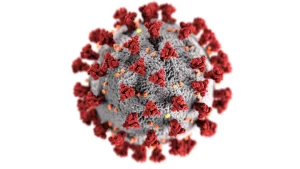10 COVID-19 facts

In this article we will describe 10 key facts about COVID-19.
1. Definition and Cause
2. Transmission
-
Respiratory droplets (coughing, sneezing, talking)
-
Close contact
-
Contaminated surfaces and objects.
3. Symptoms
-
Fever
-
Cough
-
Fatigue
-
Shortness of breath
-
Loss of taste/smell
-
Muscle pains
-
Diarrhoea.
Note 2: People who have no symptoms but test positive for COVID-19 are called asymptomatic. These make up 20% of the total.
4. Incubation and Duration
-
Incubation: Symptoms typically appear within 5-6 days (range 2-14) post-exposure
-
Duration:
-
Mild cases: 1-2 weeks
-
Severe cases: Up to 6 weeks or longer
-
Long COVID: Symptoms persisting over 3 months.
-
5. At-risk Groups
At-risk groups include:
-
Older adults (65+)
-
Young children
-
Underlying health conditions (diabetes, chronic heart disease, CKD)
-
Immunocompromised individuals.
6. Treatment
-
Medication:
-
Antivirals (Remdesivir, Lopinavir/Ritonavir, Oseltamivir, Molnupiravir, Paxlovid)
-
Anti-inflammatory drugs (Dexamethasone, Prednisolone, Tocilizumab)
-
Immunomodulators (Baricitinib, Tofacitinib)
-
-
Oxygen therapy
-
Hospitalisation +/- ICU/ventilation (severe cases).
7. Prevention
-
Vaccination
-
Mask-wearing
-
Social distancing
-
Hand hygiene
-
Avoiding crowded areas.
8. Vaccine Efficacy
9. Mortality and Complications
-
Mortality rate: Approximately 1%, varying by vaccination status, age, variant, and underlying health conditions
-
Increased mortality: 5% (75+ years), 15% (85+ years)
-
Long COVID: Affects approximately 2% of the UK population, with 70% experiencing symptoms beyond 1 year.
10. Global Impact
-
777,664,564 reported cases (WHO; updated 16 March 2025)
-
7,057,132 deaths (updated 1 April 2025)
-
Widespread economic disruption.
5 unusual facts about COVID-19
1. Loss of Smell and Taste: One of the unusual symptoms of COVID-19 is the loss of smell (anosmia) and taste (ageusia).
Research suggests that the virus damages the cells in the nose and tongue, leading to these unusual symptoms.
2. ‘COVID Toes’: Some people with COVID-19 have reported a strange symptom known as ‘COVID toes.’
This condition causes the toes to become swollen, red, and painful, often with purple or blue discoloration.
 COVID Toes
COVID Toes
3. Increased Risk of Blood Clots: COVID-19 increases the risk of blood clots (both arterial and venous), which can be life-threatening.
This is because the virus causes inflammation in the body, which can lead to the formation of blood clots.
4. Mental Health Effects: COVID-19 can (rarely) have unusual effects on mental health, including hallucinations, paranoia, and psychosis.
This is thought to be due to the virus’s impact on the brain and nervous system.
5. Long-Term Effects on Organs: Research suggests that COVID-19 can have long-term effects on various organs in the body, including the heart, lungs, kidneys, and liver.
This is because the virus can cause inflammation and autoimmune damage to these organs, leading to chronic health problems. This may be the basis of Long COVID.
Summary
We have described 10 key facts about COVID-19. We hope it has been helpful.

